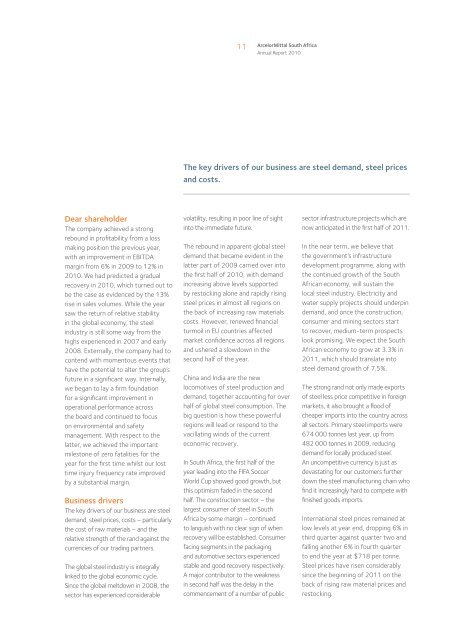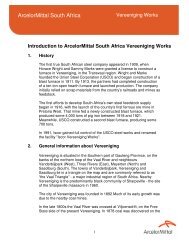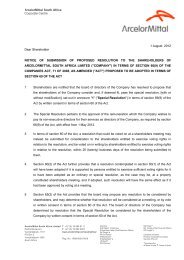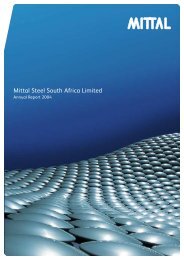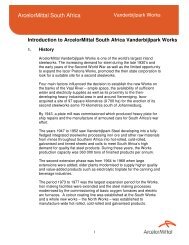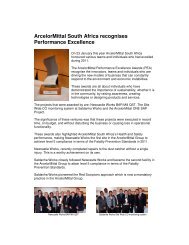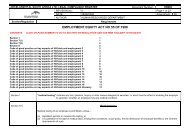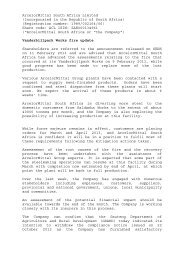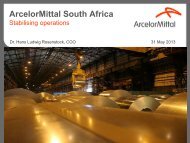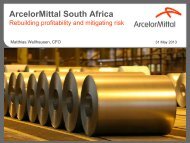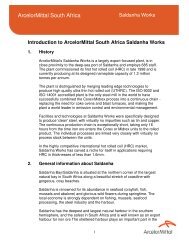bold spirit - ArcelorMittal South Africa
bold spirit - ArcelorMittal South Africa
bold spirit - ArcelorMittal South Africa
You also want an ePaper? Increase the reach of your titles
YUMPU automatically turns print PDFs into web optimized ePapers that Google loves.
11<br />
<strong>ArcelorMittal</strong> <strong>South</strong> <strong>Africa</strong><br />
Annual Report 2010<br />
The key drivers of our business are steel demand, steel prices<br />
and costs.<br />
Dear shareholder<br />
The company achieved a strong<br />
rebound in profitability from a loss<br />
making position the previous year,<br />
with an improvement in EBITDA<br />
margin from 6% in 2009 to 12% in<br />
2010. We had predicted a gradual<br />
recovery in 2010, which turned out to<br />
be the case as evidenced by the 13%<br />
rise in sales volumes. While the year<br />
saw the return of relative stability<br />
in the global economy, the steel<br />
industry is still some way from the<br />
highs experienced in 2007 and early<br />
2008. Externally, the company had to<br />
contend with momentous events that<br />
have the potential to alter the group’s<br />
future in a significant way. Internally,<br />
we began to lay a firm foundation<br />
for a significant improvement in<br />
operational performance across<br />
the board and continued to focus<br />
on environmental and safety<br />
management. With respect to the<br />
latter, we achieved the important<br />
milestone of zero fatalities for the<br />
year for the first time whilst our lost<br />
time injury frequency rate improved<br />
by a substantial margin.<br />
Business drivers<br />
The key drivers of our business are steel<br />
demand, steel prices, costs − particularly<br />
the cost of raw materials − and the<br />
relative strength of the rand against the<br />
currencies of our trading partners.<br />
The global steel industry is integrally<br />
linked to the global economic cycle.<br />
Since the global meltdown in 2008, the<br />
sector has experienced considerable<br />
volatility, resulting in poor line of sight<br />
into the immediate future.<br />
The rebound in apparent global steel<br />
demand that became evident in the<br />
latter part of 2009 carried over into<br />
the first half of 2010, with demand<br />
increasing above levels supported<br />
by restocking alone and rapidly rising<br />
steel prices in almost all regions on<br />
the back of increasing raw materials<br />
costs. However, renewed financial<br />
turmoil in EU countries affected<br />
market confidence across all regions<br />
and ushered a slowdown in the<br />
second half of the year.<br />
China and India are the new<br />
locomotives of steel production and<br />
demand, together accounting for over<br />
half of global steel consumption. The<br />
big question is how these powerful<br />
regions will lead or respond to the<br />
vacillating winds of the current<br />
economic recovery.<br />
In <strong>South</strong> <strong>Africa</strong>, the first half of the<br />
year leading into the FIFA Soccer<br />
World Cup showed good growth, but<br />
this optimism faded in the second<br />
half. The construction sector − the<br />
largest consumer of steel in <strong>South</strong><br />
<strong>Africa</strong> by some margin − continued<br />
to languish with no clear sign of when<br />
recovery will be established. Consumer<br />
facing segments in the packaging<br />
and automotive sectors experienced<br />
stable and good recovery respectively.<br />
A major contributor to the weakness<br />
in second half was the delay in the<br />
commencement of a number of public<br />
sector infrastructure projects which are<br />
now anticipated in the first half of 2011.<br />
In the near term, we believe that<br />
the government’s infrastructure<br />
development programme, along with<br />
the continued growth of the <strong>South</strong><br />
<strong>Africa</strong>n economy, will sustain the<br />
local steel industry. Electricity and<br />
water supply projects should underpin<br />
demand, and once the construction,<br />
consumer and mining sectors start<br />
to recover, medium-term prospects<br />
look promising. We expect the <strong>South</strong><br />
<strong>Africa</strong>n economy to grow at 3.3% in<br />
2011, which should translate into<br />
steel demand growth of 7.5%.<br />
The strong rand not only made exports<br />
of steel less price competitive in foreign<br />
markets, it also brought a flood of<br />
cheaper imports into the country across<br />
all sectors. Primary steel imports were<br />
674 000 tonnes last year, up from<br />
482 000 tonnes in 2009, reducing<br />
demand for locally produced steel.<br />
An uncompetitive currency is just as<br />
devastating for our customers further<br />
down the steel manufacturing chain who<br />
find it increasingly hard to compete with<br />
finished goods imports.<br />
International steel prices remained at<br />
low levels at year end, dropping 6% in<br />
third quarter against quarter two and<br />
falling another 6% in fourth quarter<br />
to end the year at $718 per tonne.<br />
Steel prices have risen considerably<br />
since the beginning of 2011 on the<br />
back of rising raw material prices and<br />
restocking.


